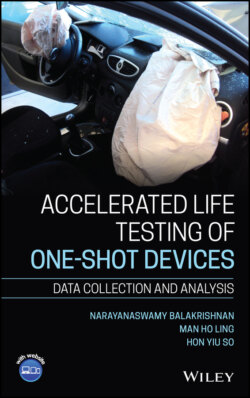Читать книгу Accelerated Life Testing of One-shot Devices - Narayanaswamy Balakrishnan - Страница 13
1.2 One‐Shot Devices
ОглавлениеValis et al. (2008) defined one‐shot devices as units that are accompanied by an irreversible chemical reaction or physical destruction and could no longer function properly after its use. Many military weapons are examples of one‐shot devices. For instance, the mission of an automatic weapon gets completed successfully only if it could fire all the rounds placed in a magazine or in ammunition feed belt without any external intervention. Such devices will usually get destroyed during usual operating conditions and can therefore perform their intended function only once.
Shaked and Singpurwalla (1990) discussed the submarine pressure hull damage problem from a Bayesian perspective and assessed the effect of various strengths of underwater shock waves caused by either a nuclear device or a chemical device on the probability of damage to a submarine pressure hull. A record is made of whether a copy of a diminutive model of a submarine pressure hull is damaged or not, and a specific strength of the shock wave on the model. Fan et al. (2009) considered electro‐explosive devices in military applications, which induct a current to excite inner powder and make them explode. Naturally, we cannot adjudge the functioning condition of the electro‐explosive device from its exterior, but can only observe it by detonating it directly. After a successful detonation, the device cannot be used anymore; if the detonation becomes a failure, we will also not know when exactly it failed. Nelson (2003) described a study of crack initiation for turbine wheels. Each of the 432 wheels was inspected once to determine whether it had started to crack or not. Newby (2008) provided some other examples of one‐shot devices, such as fire extinguishers or munitions. A full test would require the use of the considered devices and, therefore, their subsequent destruction. The test carried out would show whether a device is still in a satisfactory state, or has failed by that inspection time.
One‐shot device testing data also arise in destructive inspection procedures, wherein each device is allowed for only a single inspection because the test itself results in its destruction. Morris (1987) presented a study of 52 Li/SO storage batteries under destructive discharge. Each battery was tested at one of three inspection times and then classified as acceptable or unacceptable according to a critical capacity value.
Ideally, reliability data would contain actual failure times of all devices placed on test (assuming, of course, the experimenter could wait until all devices fail), so that the observed failure times can reveal the failure pattern over time, and we could then estimate the reliability of the device reasonably. But, in practice, many life‐tests would get terminated before all the units fail. Such an early stoppage of the life‐test by the experimenter may be due to cost or time constraints or both. This would result in what is called as “right‐censored data” because the exact failure times of the unfailed devices are unknown, but all we know is that the failure times of those devices are larger than the termination time. Considerable literature exists on statistical inference for reliability data under right‐censoring; for example one may refer to the books by Cohen (1991), Balakrishnan and Cohen (1991), and Nelson (2003).
Moreover, when nondestructive and periodic inspections are carried on devices, their exact failure times will not be observed, but the intervals wherein the failures occurred will only be available. If a failure is observed by the first inspection, then it is known that the failure time of the device is less than the first inspection time, resulting in “left‐censoring.” Similarly, if a failure is observed between two consecutive inspection times, then it is known that the failure time is between these two corresponding inspection times, resulting in “interval‐censoring.” Finally, the failure times of all surviving units at the final inspection time are right‐censored as their exact failure times will not be observed. Exact failure times can only be observed from a life‐testing experiment with continuous surveillance. The periodic inspection process with nondestructive evaluation would actually provide a reasonable approximation to failure times of devices under test, especially when the inspection time intervals are short, even though the precision of inference will be less in this case.
It is useful to note that in all the preceding examples of one‐shot devices, we will not observe the actual lifetimes of the devices. Instead, we would only observe either a success or a failure at the inspection times, and so only the corresponding binary data would be observed, consequently resulting in less precise inference. In this manner, one‐shot device testing data differ from typical data obtained by measuring lifetimes in standard life‐tests and, therefore, poses a unique challenge in the development of reliability analysis, due to the lack of lifetime information being collected from reliability experiments on such one‐shot devices. If successful tests occur, it implies that the lifetimes are beyond the inspection times, leading to right‐censoring. On the other hand, the lifetimes are before the inspection times, leading to left‐censoring, if tests result in failures. Consequently, all lifetimes are either left‐ or right‐censored. In such a setting of the lifetime data, Hwang and Ke (1993) developed an iterative procedure to improve the precision of the maximum likelihood estimates for the three‐parameter Weibull distribution and to evaluate the storage life and reliability of one‐shot devices. Some more examples of one‐shot devices in the literature include missiles, rockets, and vehicle airbags; see, for example, Bain and Engelhardt (1991), Guo et al. (2010), and Yun et al. (2014).
